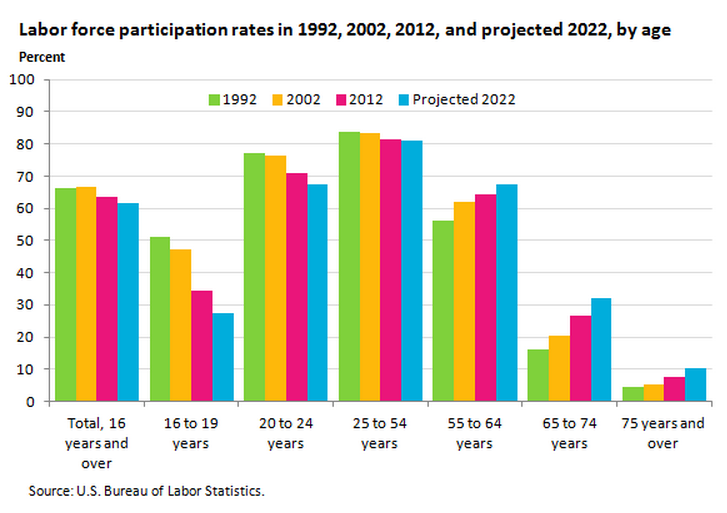...will be older, (relatively smaller), more non-white, and will certainly have more robot participation...
First, here is the chart, courtesy of our friends at the Bureau of Labor Statistics:

And below are the key findings from the aggregate data presented in the chart above, as well as in the details on gender, ethnicity, and sub-age group data (all found from the BLS in a piece titled "Labor force projections to 2022: the labor force participation rate continues to fall").
The Bureau of Labor Statistics (BLS) projects that the next 10 years will bring about an aging labor force that is growing slowly, a declining overall labor force participation rate, and more diversity in the racial and ethnic composition of the labor force.
The labor force participation rate increased in the 1970s, 1980s, and 1990s and reached an all-time high during the 1997–2000 period. The rate declined during and after the 2001 recession before stabilizing from 2004 to 2008. The labor force participation rate fell in 2009 and continued to fall after the 2007–2009 recession ended. As the baby-boom generation ages and begins to retire, BLS projects that the overall labor force participation rate will continue to decline to 2022.
During the 2012–2022 period, the growth of the labor force is anticipated to be due entirely to population growth, as the overall labor force participation rate is expected to decrease from 63.7 percent in 2012 to 61.6 percent in 2022.
There is lots more in the details from the BLS piece, but I think you get the gist. And if you have been following this trend for any amount of time, you are probably not really surprised by the data.
What is surprising, at least to me, is that whenever a new monthly employment report is released by the DOL that the talking heads on the business news continue to lament the low (and declining) labor participation rates, and speculate on the reasons why and the potential policies that could reverse this trend.
If these 2022 projections from the BLS are accurate, or even close, I wonder if it makes more sense to quit trying to bring back the days of 2000 or so, and instead focus on what a smaller, more diverse, and older labor force means to our organizations and our economy.
No fiscal program is going to turn back the clock for all the aging boomers. And hardly any feasible rise in the minimum wage is going to convince more 16 - 24 year olds that they would be better off working more and going to school less.
The only age groups where participation is increasing are 55+.
Keep that in mind this year as you are working on your 5 - 10 year business plans.
Happy Wednesday.